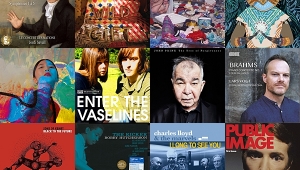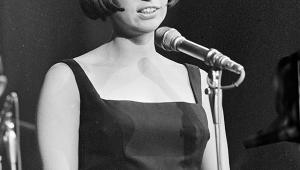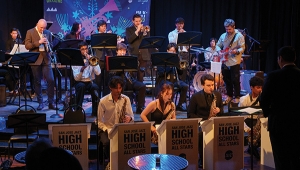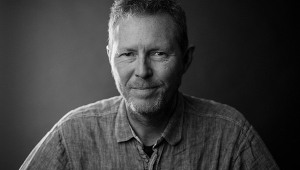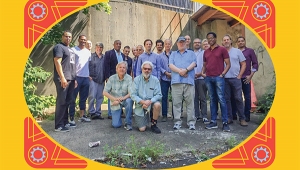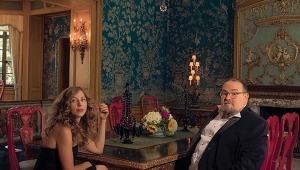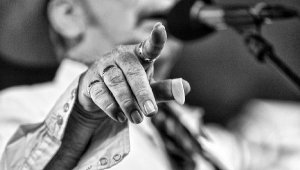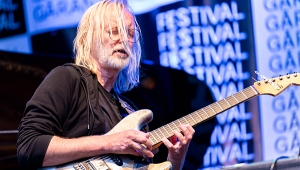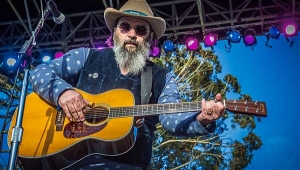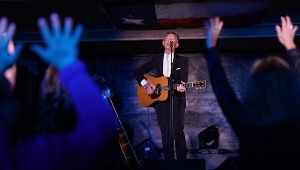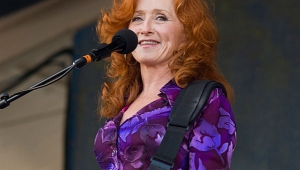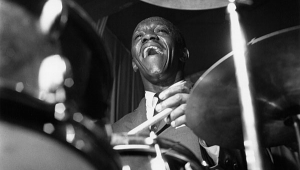| Columns Retired Columns & Blogs |
Comfort and Joy: the making of Cantus' Christmas CDs
"I can't make out the words."
Footnote 1: The subsequent release of Metric Halo's beta recording software for their components meant that I could dispense with tape for the next Cantus project, a collection of songs about the sea with instrumental accompaniment. For the sessions in June 2005, I used my laptop alone as a multichannel recorder, storing the data as mono SD2 files on a FireWire 800-connected hard drive (although, cautious as ever, I did run tape as backup).
My wife was right. I knew I had the lush-sounding, rearmost pair of omni mikes too high in the mix, but I had so wanted her to listen to the first edit of "Silent Night." When I assemble a performance on the digital audio workstation, I'm not listening at all to the music, except in fragments as I work from the producer's notes and fine-tune each crossfade so that one take seamlessly slides into the next. But when I finally sat back to listen to the finished product, not only did Brian Arreola's arrangement, with its shifting time signatures, breathe new life into this overfamiliar carol, but his angelic voice, floating over murmured "oohs" from the rest of the singers, raised goosebumps on my arms and sent shivers down my spine.
 I reduced the level of the omnis so that the clarity of the main cardioid pair could come forward in the mix, and now the words were clear. But more important, the magic I had heard from Cantus live in the concert hall at Goshen College was still intact. One track down, 31 to go.
I reduced the level of the omnis so that the clarity of the main cardioid pair could come forward in the mix, and now the words were clear. But more important, the magic I had heard from Cantus live in the concert hall at Goshen College was still intact. One track down, 31 to go.
Sessions
Cantus' artistic director, Erick Lichte, had asked me to record the Minnesota male-voice choir in the fall of 2000, and since then I have engineered three CDs. Let Your Voice Be Heard (Cantus CTS-1201), released in 2001, is a celebration of world music; Against the Dying of the Light . . . (CTS-1202), released in 2002, remembers the tragedy of 9/11 by taking the listener on a journey from the depths of despair to the pinnacles of joy; and Deep River (CTS-1203), released in 2003, is a treasury of African-American spirituals.
 Each album had presented its own challenges regarding hall acoustics and ensemble balance, but in addition, each project had been more complex than the one before. Let Your Voice . . . had been recorded with four mikes—a central ORTF pair of cardioids with outrigger omnis—in 24-bit PCM at 44.1kHz on a Nagra-D recorder. For Light . . . , I used the same mike array but increased the sample rate to 88.2kHz, which meant I had to add a second tape recorder, a Tascam DA-38, each recorder then storing the data for two mike channels. For Deep River, I had kept the high sample rate and added a second pair of omnis, placed each side of a Jecklin baffle to give me the option of increasing soundstage depth in the final mix. As well as the Nagra and Tascam recorders, I used a PC, fitted with an RME soundcard and running the predecessor to Adobe's excellent Audition program, to store the additional mike channels as AIF files.
Each album had presented its own challenges regarding hall acoustics and ensemble balance, but in addition, each project had been more complex than the one before. Let Your Voice . . . had been recorded with four mikes—a central ORTF pair of cardioids with outrigger omnis—in 24-bit PCM at 44.1kHz on a Nagra-D recorder. For Light . . . , I used the same mike array but increased the sample rate to 88.2kHz, which meant I had to add a second tape recorder, a Tascam DA-38, each recorder then storing the data for two mike channels. For Deep River, I had kept the high sample rate and added a second pair of omnis, placed each side of a Jecklin baffle to give me the option of increasing soundstage depth in the final mix. As well as the Nagra and Tascam recorders, I used a PC, fitted with an RME soundcard and running the predecessor to Adobe's excellent Audition program, to store the additional mike channels as AIF files.
So when Erick asked me in late 2003 if I would record the next Cantus project, a two-CD set of Christmas music to be called Comfort and Joy, I wasn't too surprised when he told me he wanted to record rear channels also, in case the recording could one day be released as a multichannel SACD or DVD-Audio disc. Okay, eight channels instead of six. How hard could it be? I toyed with the idea of using just a PC or Mac, running a multichannel DAW (digital audio workstation) program for the C&J sessions, but conservatism, coupled with my unwillingness to commit to unknown software, led me to expand on what I knew had worked before.
Fig.1 shows the setup. Yes, it's complex (footnote 1). I would use my Apple PowerBook, running BIAS's Peak 4.0 program and hooked up to a FireWire-connected Metric Halo MIO 2882, as a fourth two-channel, 24-bit/88.2kHz recorder. A second Metric Halo unit, a ULN-2, would act as both low-noise mike preamp and A/D converter for the PC recorder. To complicate things even more, digital converter company dCS had asked if I would review their Verona Master Clock, so I decided to use that to feed a clean, low-jitter word clock to the four A/D converters. But just to keep things from being too easy, it turned out that the two Metric Halo boxes wouldn't lock reliably to the Verona's signal when it was outputting an 88.2kHz clock.

Fig.1 The complex recording setup used for both volumes of Comfort and Joy. Analog links are indicated in red, digital links in blue, word-clock connections in green, and FireWire connections in magenta.
I therefore set the two dCS 904 converters to run at 88.2kHz, but to derive their clock reference from the Verona set to 44.1kHz via 75-ohm links. (The Verona can distribute a double-speed clock but can only generate 44.1kHz and 48kHz clocks.) I then ran an AES/EBU link from the 904s' 88.2kHz clock-reference outputs, which don't carry any jitter-adding audio data, to each of the Metric Halo boxes (footnote 2). This way, each 904 would be both slaved to the Verona and have a Metric Halo converter slaved in turn to it. All eight channels I was recording would thus be locked to the same word clock, with never more than two clock links back to the Verona. (With the converters word-clock–synchronized, the fact that four heterogeneous recorders were used becomes a nonissue, the sampling points in the resultant sound files being time-coincident.)

Goshen College, in the Amish country of northern Indiana, was founded and is run by the Mennonites, who take music very seriously. Though it has an enrollment of only about 1000 students, in 2002 it opened two state-of-the-art performance spaces. Not only is the larger of these, the 1000-seat Sauder Hall, a classic shoe-box shape, but its reverberation time can be adjusted from just over a second to more than three seconds by opening heavy drapes around its perimeter. Cantus had discovered its superbly sympathetic acoustics when they gave a concert and a series of vocal master classes there. Given that many of the works we were to record demanded a large, supportive acoustic, it seemed a no-brainer to use Sauder Hall for the Comfort and Joy sessions.
Microphone placement is always the dominant issue in a recording. Positioning microphones in the perfect position in the hall and recording to analog cassette will give a more satisfying sound than the wrong mike placement and a state-of-the-art digital recorder. My starting points for the three main mike pairs—a pair of DPA 4011 cardioids arranged as an ORTF pair (capsules 7" apart and angled at 110°), a pair of DPA 4006 omnis spaced by 11', a pair of high-voltage DPA 4003 omnis fitted with spherical acoustic equalizers and with their capsules around 10" apart on either side of a Jecklin disc and each angled away from the baffle at 45°—were the positions that had worked well for Deep River, which I'd recorded in Sioux Falls' slightly larger Washington Pavilion in 2003.

After some fine-tuning, the spaced omnis and cardioids were on an arc just over 20' from the center of the choir, the Jecklin omnis some 5' farther back. All the mikes were about 6' above the singers' heads. The two front pairs of mikes gave a balance that was a little too upfront to be used alone, the rear omnis one that was a little too "wet." This was what I was aiming for; in postproduction, I could vary the ratio between the direct sound and the hall reverberation by changing the relative levels of the three pairs of mikes.
For the rear channels, I had to rely more on guesswork than skill. The only three Stereophile projects that I had recorded in surround were Serenade (1996), Rhapsody (1997), and Duet (1998)—the CDs, available from www.stereophile.com, were mixed from the front channels only—and my experience from the test mixes I had made back then was that it is very hard to produce a satisfying surround recording by using the front two channels of a minimalist stereo recording as the multichannel Left and Right channels—when the surround channels are added, you end up with just two much reverberation. However, as I was going to use the Jecklin omnis to compensate in the two-channel mix for the rather too-close placement of the other two mike pairs, I thought it possible in these sessions merely to add a fourth pair of microphones for the surround information. These were an ORTF pair of Shure SM-81s—my favorite affordable cardioid—placed 5' behind the Jecklin omnis and facing the rear corners of the hall.
Footnote 1: The subsequent release of Metric Halo's beta recording software for their components meant that I could dispense with tape for the next Cantus project, a collection of songs about the sea with instrumental accompaniment. For the sessions in June 2005, I used my laptop alone as a multichannel recorder, storing the data as mono SD2 files on a FireWire 800-connected hard drive (although, cautious as ever, I did run tape as backup).
Footnote 2: To my surprise, the theoretically superior 75-ohm word-clock links gave worse measured performance from the MIO and ULN-2. (Before I roll tape/hard drive on a project, I check out the system by recording a high-level 20kHz tone on every channel.) This anomaly has since been fixed by Metric Halo with firmware updates.
- Log in or register to post comments
